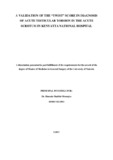| dc.contributor.author | Moosajee, Hussein S | |
| dc.date.accessioned | 2017-12-13T06:51:24Z | |
| dc.date.available | 2017-12-13T06:51:24Z | |
| dc.date.issued | 2017 | |
| dc.identifier.uri | http://hdl.handle.net/11295/101816 | |
| dc.description.abstract | The acute scrotum is a common urological emergency. The differential diagnosis of the acute scrotum is broad. A focused history and physical examination can at most times make an accurate diagnosis. A common cause of acute scrotal pain is testicular torsion. Any delay in diagnosis results in poor outcomes such as testicular loss or sub-fertility. A timely diagnosis of testicular torsion can result in improved testicular salvage rates hence immediate recognition is vital to management. There is no clear consensus on a particular algorithm to be followed in the diagnosis of testicular torsion. Traditionally, clinical examination followed by surgical exploration was the norm, but this resulted in unnecessary surgeries and increased morbidity and overall costs. Imaging modalities have been frequently used to assist in formulating a diagnosis however this also results in delays to definitive management and increased costs. A clinical tool such as the TWIST Score, which is a risk scoring system based on signs and symptoms, can be invaluable in management of patients with acute scrotum, specifically testicular torsion, as it can guide clinicians on decisions towards timely management of the patient with an acute scrotum.
Study Objective
To validate the efficacy of the TWIST Score in diagnosing testicular torsion in patients presenting with an acute scrotum.
Methodology
This was a prospective cross sectional study on male patients with acute scrotum who presented at the Kenyatta National Hospital (KNH) Adult and Paediatric Accident and Emergency Department, Paediatric and Surgical Outpatient clinics, and Paediatric and Surgical wards, carried out over a duration of 9 months. The estimated sample size was 60 male patients.
Recruited patients signed informed consent voluntarily and data collected on a structured pretested questionnaire which included age at diagnosis, time of onset of pain, first point of contact, history and physical examination findings, any adjunct test done, intra-operative findings and follow up findings of patients at low risk.
Data was managed using MS Excel and analyzed using SPSS version 21.0. Continuous data was presented as means and categorical variables as summarized percentages. The efficacy of the TWIST score in diagnosing testicular torsion was determined by calculating its sensitivity, specificity, positive predictive value (PPV), negative predictive value (NPV) and accuracy. Receiver-operator characteristic (ROC) curve was drawn for sensitivity and specificity. All statistical tests were conducted at 5% level of significance. The data is presented in form of tables and graphs.
Results
From the 60 patients enrolled into the study, 44 patients (73.3%) had testicular torsion. The mean age was 23 years. With all patients enrolled, 45 patients were classified as high risk as per the TWIST Score with 3 patients being classified as low risk. The remaining 12 patients were classified in the intermediate group. Positive predictive value for the TWIST Score was 95.6%. Negative predictive value for the TWIST Score in this study was 100% however the number of patients enrolled in this group was low. A low testicular salvage rate of 9.1% was obtained.
Conclusions
The use of the TWIST Score in clinical practice is accurate in determining high risk patients who can proceed straight to the operating theatre without need of an ultrasound while low risk patients can be treated without the use of an ultrasound. | en_US |
| dc.language.iso | en | en_US |
| dc.publisher | University of Nairobi | en_US |
| dc.rights | Attribution-NonCommercial-NoDerivs 3.0 United States | * |
| dc.rights.uri | http://creativecommons.org/licenses/by-nc-nd/3.0/us/ | * |
| dc.subject | Diagnosis of Acute Testicular Torsion | en_US |
| dc.title | A Validation of the “twist” Score in Diagnosis of Acute Testicular Torsion in the Acute Scrotum in Kenyatta National Hospital | en_US |
| dc.type | Thesis | en_US |
| dc.description.department | a
Department of Psychiatry, University of Nairobi, ; bDepartment of Mental Health, School of Medicine,
Moi University, Eldoret, Kenya | |



